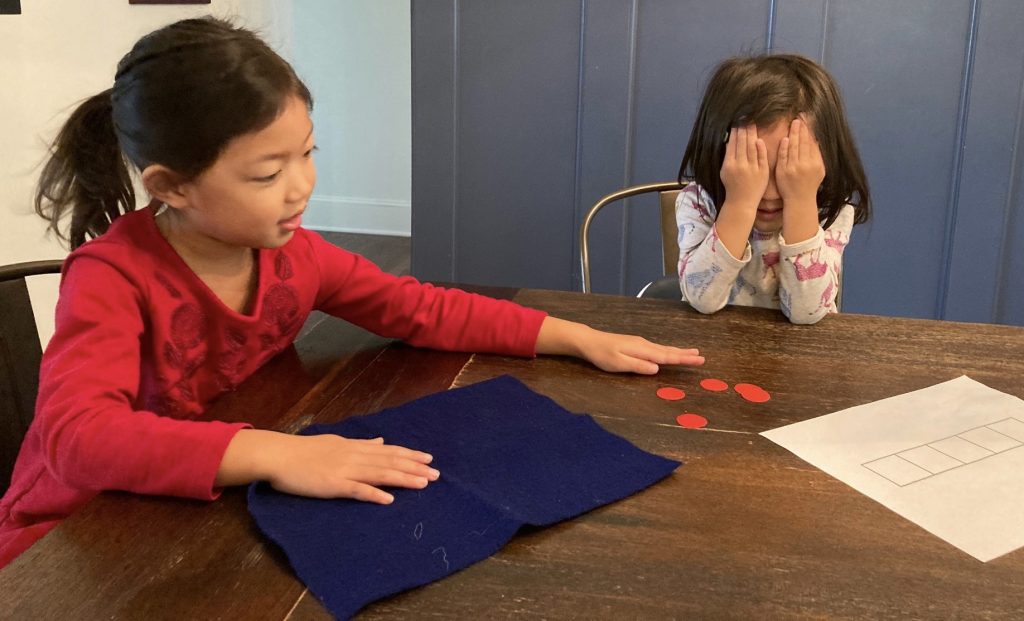Materials
- Identical counters (TIP: Choosing interesting counters and/or cover object is an easy way to tie in a theme, but make sure they are not too distracting.)
- Number line or five-frame
- A cover object
Setup — Less than 5 minutes
- Choose a cover object. It can be made out of anything, including a piece of paper or fabric, a cup, or a hat
- Set out counters, a number line or five-frame, and a cover object. If children have previously used a number line or five-frame, choose the one with which they are familiar. Children may need scaffolding initially to use these tool
Instructions
1. A pair of students takes turns being the Estimator and the Hider.
2. The Estimator places the 5 counters on a number line or five-frame. (TIP: You can also use 3 or 10 counters, depending on the children’s skill level.)
3. The Estimator closes their eyes, turns around, or puts their head down, while the Hider takes some of the counters and hides them under the cover object.
4. The Estimator looks at the remaining counters and determines how many are missing by using addition and subtraction. They can use the number line or five-frame to help determine how many the Hider took.
5. The Hider reveals the hidden counters and they count them all together.
6. The Estimator and the Hider switch roles and continue taking turns.

Checks for Understanding
To deepen children’s learning about early math concepts, talk and ask questions while doing this activity together. Here are some examples to get you started.
- To the Estimator: “Can you count the counters that are not hidden?”
- “How many counters are hidden?”
- “How many counters do you have?”
- To the Estimator: “How many counters are left?”
- “If I have 5 counters and I want 3, how many should I take away?”
- “If I have 3 counters and I want 5, how many more do I need?”
Activity Modifications
Once you have tried out the activity, here are some other things you can do. Try these modifications to keep the activity interesting and challenging for students all year.
- Have the Hider secretly draw number cards showing numerals, dots, or both to determine how many counters to remove each round.
- Shift children’s focus to visually comparing magnitude. When the Estimator’s eyes are closed, the Hider can either add or take away some counters. The Estimator decides then if the new collection is larger or smaller. You can use more counters (e.g., 20), because children just need to estimate and not count. Encourage children to add/remove more than just a few counters. Support using larger quantities with a ten-frame or a double ten-frame.
- The Estimator chooses the starting number of counters. While the Estimator looks away, the Hider adds counters. The Estimator determines how many were added.
- Use more than five counters for students who are ready to work with larger numbers. Support using larger quantities with a longer number line, ten-frame, or double ten-frame.
- Give the Estimator five counters of one color or type and five of another color or type. The Hider can take away counters from either or both sets, and the Estimator has to figure out how many of each color were taken. Five frames or a ten frame may be helpful for children challenged by multiple sets of counters.
Choosing interesting materials is an easy way to tie in a theme, but make sure they don’t distract attention from the activity. Here are two theme suggestions:
- Magicians: The Hider is a magician and is going to choose how many coins they want to hide under their hat. The Estimator is the magician’s assistant who will then have to guess how many are hidden. Give the Hider a hat or a printed picture of a hat under which to hide the counters.
- Feed the Animals: The Hider hides the counters under a stuffed animal and the Estimator figures out how many counters the animal ate.